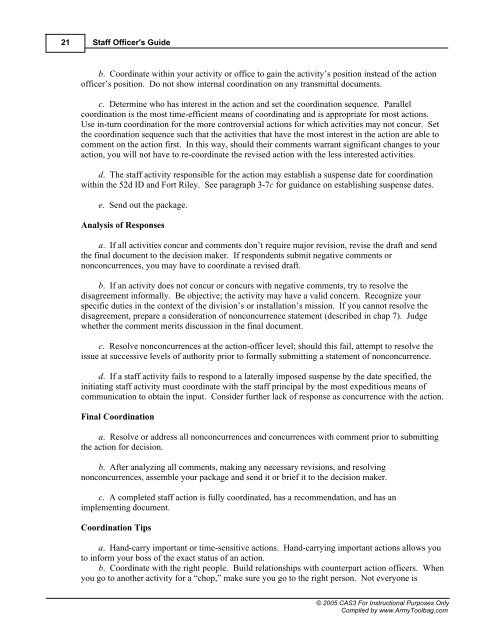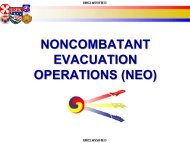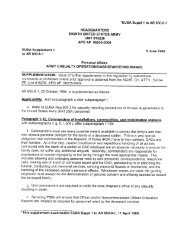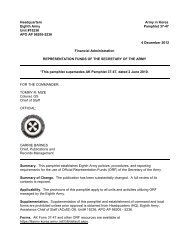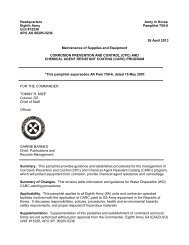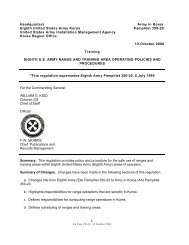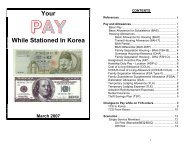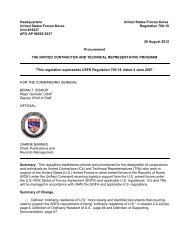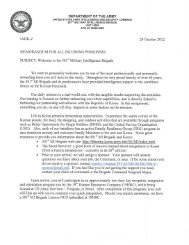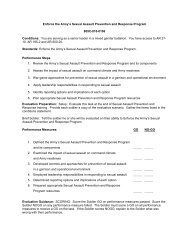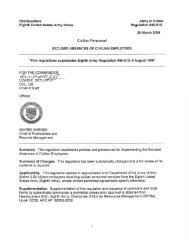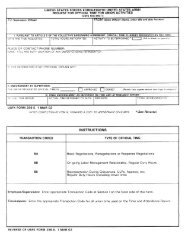CAS3 Staff Officer Guide - U.S. Army
CAS3 Staff Officer Guide - U.S. Army
CAS3 Staff Officer Guide - U.S. Army
Create successful ePaper yourself
Turn your PDF publications into a flip-book with our unique Google optimized e-Paper software.
21<br />
<strong>Staff</strong> <strong>Officer</strong>'s <strong>Guide</strong><br />
b. Coordinate within your activity or office to gain the activity’s position instead of the action<br />
officer’s position. Do not show internal coordination on any transmittal documents.<br />
c. Determine who has interest in the action and set the coordination sequence. Parallel<br />
coordination is the most time-efficient means of coordinating and is appropriate for most actions.<br />
Use in-turn coordination for the more controversial actions for which activities may not concur. Set<br />
the coordination sequence such that the activities that have the most interest in the action are able to<br />
comment on the action first. In this way, should their comments warrant significant changes to your<br />
action, you will not have to re-coordinate the revised action with the less interested activities.<br />
d. The staff activity responsible for the action may establish a suspense date for coordination<br />
within the 52d ID and Fort Riley. See paragraph 3-7c for guidance on establishing suspense dates.<br />
e. Send out the package.<br />
Analysis of Responses<br />
a. If all activities concur and comments don’t require major revision, revise the draft and send<br />
the final document to the decision maker. If respondents submit negative comments or<br />
nonconcurrences, you may have to coordinate a revised draft.<br />
b. If an activity does not concur or concurs with negative comments, try to resolve the<br />
disagreement informally. Be objective; the activity may have a valid concern. Recognize your<br />
specific duties in the context of the division’s or installation’s mission. If you cannot resolve the<br />
disagreement, prepare a consideration of nonconcurrence statement (described in chap 7). Judge<br />
whether the comment merits discussion in the final document.<br />
c. Resolve nonconcurrences at the action-officer level; should this fail, attempt to resolve the<br />
issue at successive levels of authority prior to formally submitting a statement of nonconcurrence.<br />
d. If a staff activity fails to respond to a laterally imposed suspense by the date specified, the<br />
initiating staff activity must coordinate with the staff principal by the most expeditious means of<br />
communication to obtain the input. Consider further lack of response as concurrence with the action.<br />
Final Coordination<br />
a. Resolve or address all nonconcurrences and concurrences with comment prior to submitting<br />
the action for decision.<br />
b. After analyzing all comments, making any necessary revisions, and resolving<br />
nonconcurrences, assemble your package and send it or brief it to the decision maker.<br />
c. A completed staff action is fully coordinated, has a recommendation, and has an<br />
implementing document.<br />
Coordination Tips<br />
a. Hand-carry important or time-sensitive actions. Hand-carrying important actions allows you<br />
to inform your boss of the exact status of an action.<br />
b. Coordinate with the right people. Build relationships with counterpart action officers. When<br />
you go to another activity for a “chop,” make sure you go to the right person. Not everyone is<br />
© 2005 <strong>CAS3</strong> For Instructional Purposes Only<br />
Compiled by www.<strong>Army</strong>Toolbag.com


